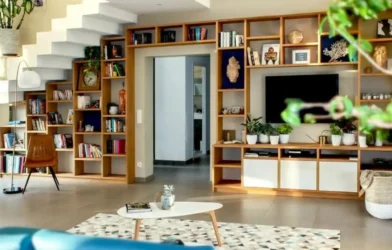In today’s fast-paced urban life, surrounded by screens, concrete walls, and artificial lighting, our connection with nature is often lost. Yet, research consistently shows that humans thrive in natural environments. This is where biophilic design comes into play—a concept that beautifully marries architecture and nature to promote well-being, mental clarity, and emotional balance.
For Indian households, students, and working professionals alike, integrating biophilic design can transform homes, offices, and classrooms into soothing, inspiring spaces. Let’s explore how this design philosophy can lead to healthier and happier living environments, especially within the context of modern Indian living.
What is Biophilic Design?
Biophilic design is an architectural and interior design approach that seeks to reconnect people with nature. The word biophilia means “love of life or living systems” and was popularized by biologist Edward O. Wilson. This design philosophy integrates natural elements—like light, air, greenery, water, and organic materials—into built environments to mimic the benefits of being outdoors.
Key Elements of Biophilic Design:
- Natural light and airflow
- Indoor plants and green walls
- Natural materials like wood, bamboo, stone, jute
- Water features (e.g., fountains, aquariums)
- Earthy color palettes and nature-inspired textures
- Outdoor views or visual connections to greenery
Why Biophilic Design Matters in Indian Living Spaces
India is experiencing rapid urbanisation. High-rise apartments, compact homes, and closed office spaces are becoming the norm—often at the cost of losing touch with nature. Biophilic design addresses this gap by:
- Reducing stress and anxiety levels
- Boosting productivity and focus (ideal for work-from-home professionals and students)
- Enhancing mood and emotional well-being
- Improving indoor air quality through plants
- Encouraging a sense of spiritual and cultural balance rooted in nature
A Real-Life Indian Context:
In cities like Delhi, Mumbai, and Bengaluru—where pollution and high stress levels are common—homes with indoor plants, open balconies, and nature-inspired decor have become sanctuaries for better health and peace of mind.
Health Benefits of Biophilic Design
Scientific studies have shown the immense benefits of integrating natural elements into indoor spaces.
Physical Health:
- Improved air quality: Plants like snake plant, money plant, and aloe vera remove indoor toxins.
- Better sleep quality: Exposure to natural light during the day regulates sleep cycles.
- Lower blood pressure and heart rate in environments with natural visuals and sounds.
Mental Health:
- Decreased levels of cortisol, the stress hormone
- Improved focus and memory retention, especially in students
- Greater emotional resilience and calmness
A 2020 study published in the Journal of Environmental Psychology found that office workers in spaces with biophilic elements reported 15% higher well-being and 6% more productivity than those in standard workspaces.
How to Incorporate Biophilic Design in Indian Homes and Workspaces
You don’t need a massive budget or a complete renovation to apply biophilic design principles. Here are simple, actionable ideas tailored for Indian environments:
Use Indoor Plants
- Beginner-friendly options: Tulsi, spider plant, snake plant, pothos (money plant), areca palm
- Place plants near windows, on study desks, or in bathrooms for a refreshing look.
Maximize Natural Light
- Use sheer curtains to allow sunlight
- Arrange workstations near windows or balconies
Choose Natural Materials
- Opt for bamboo, cane, jute, and wooden furniture
- Decorate with stone artefacts or terracotta pots
Add Water Elements
- Small tabletop fountains
- A fish aquarium brings serenity and life
Earthy Colours & Textures
- Use forest green, terracotta, beige, and ocean blue in paint, upholstery, or rugs
- Choose fabrics like khadi, cotton, or handwoven textiles
Create Outdoor-Inspired Spaces
- Convert balconies into mini gardens
- Install hanging planters, fairy lights, and bamboo blinds
Cultural Harmony: Biophilic Design & Indian Traditions
Indian culture has always had a strong connection with nature—be it through Vastu Shastra, Ayurveda, or yoga. Biophilic design harmonizes with these practices beautifully:
- Tulsi plant in courtyards symbolizes health and positivity
- Courtyard houses in South India offer natural ventilation and greenery
- Open terraces with creepers and flowering plants create a spiritual, calm vibe
By integrating biophilic principles, modern Indian interiors can retain cultural roots while embracing sustainability and wellness.
Biophilic Design: A Growing Trend in India
- According to a 2023 survey by India Design Journal, over 62% of Indian homeowners prefer homes with natural light and green views.
- Leading Indian architecture firms are now incorporating green roofs, vertical gardens, and open atriums in residential and commercial projects.
- Co-working spaces like WeWork India and 91Springboard now feature indoor greenery, enhancing employee satisfaction.
Conclusion: A Greener Path to Wellness
Biophilic design is more than just a trend—it’s a lifestyle shift that promotes harmony, health, and happiness. Whether you are a student studying in a dorm room, a working professional in a small flat, or a homemaker redesigning your living room—bringing nature indoors can make a world of difference.
In the Indian context, where cultural values already align with nature’s rhythm, embracing biophilic design is not only easy but deeply fulfilling. With a few mindful changes, your home or office can become a space that nurtures your body, mind, and spirit—naturally.
SEO Keywords Used:
- Biophilic design in India
- Nature-inspired interiors
- Health benefits of biophilic design
- Indoor plants for Indian homes
- Natural home decor ideas
- Sustainable interior design India
- Stress relief through home design
- Nature-based living spaces
Would you like me to create a downloadable PDF version of this article or suggest social media captions to promote it?








